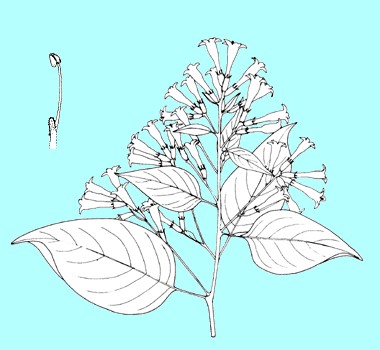
Synonymy
*Cestrum aurantiacum Lindley, Edwards's Bot. Reg. 30: misc. 71, no. 65 (1844); 31: t. 22 (1845)
T: Described from plants cultivated in Chiswick Gardens from seed said to be native to Chimalapa, Guatamala; n.v.
Distribution and ecology
Occasionally cultivated as garden plant; now an uncommon weed in south-eastern Qld and coastal N.S.W. with one record from Mt Gambier in S.A.
Occurs in waste places mostly in urban areas.
Common name
Orange cestrum
Notes
Toxic to sheep and cattle.
Flowers are reported to have a citrus-like aroma at night.
There is variation in this species with respect to hair covering in the material in AD at least. In some specimens the calyces, pedicels and inner face of the corolla lobes are glabrous (Bates 30977), while in others they are clearly pubescent (Annett s.n.). As well as this the shape of the calyx lobes is also variable, with some specimens being more or less ribbed (Bates 30977); this specimen is also glabrous within the corolla tube except at the point of insertion of the stamens, whereas the other specimen is hairy within the tube proper and on the lower half of the filaments.
There could be two species being confused here and more investigation of the specimens involved is required.
Selected specimens
Qld: Tamborine, 15 June 1959, T.C. Wilcox (BRI). N.S.W.: Upper Cordeaux Dam, 2 May 1957, E.F. Constable (NSW).
Derivation of epithet
From aurantiacus, Latin for orange, a reference to the colour of the flowers.
Images and information on web
For colour photo of the flowers and leaves of C. aurantiacum see the Desert-Tropicals page at http://www.desert-tropicals.com/Plants/Solanaceae/Cestrum_aurantiacum.html and at the CalPhotos site.
Images of the flowers and fruits can also be seen on the Flora of Zimbabwe site at http://www.zimbabweflora.co.zw/speciesdata/species.php?species_id=150840
A line drawing of C. aurantiacum and C. nocturnum is shown on the Flora of China page at http://digitalis.mobot.org/mrsid/296/29602084_001.gif
A fact sheet on the effects of ingestion of green and orange cestrum species on animals can be downloaded from the Australian Weeds and Livestock pages dealing with the effects of plants on various farm animals.
Further information about the toxic properties of this plant can be found with a search in the FDA Poisonous Plant Database